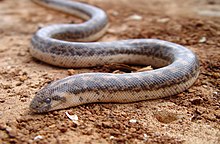Eryx (snake)
| Eryx | |
|---|---|

| |
| Javelin sand boa, E. jaculus | |
| Scientific classification | |
| Domain: | Eukaryota |
| Kingdom: | Animalia |
| Phylum: | Chordata |
| Class: | Reptilia |
| Order: | Squamata |
| Suborder: | Serpentes |
| Family: | Boidae |
| Subfamily: | Erycinae |
| Genus: | Eryx Daudin, 1803 |
| Synonyms[1] | |
Eryx is a genus of nonvenomous boas known as Old World sand boas.[2] They are found in southeastern Europe, northern Africa, the Middle East, and southwestern Asia. Nine species are currently recognized.[2]
Description
The genus Eryx has the following characters. The head is not distinct from the neck. The dorsal surface of the head is covered with small scales. The rostral is large. The eyes range from small to very small, and the pupils are vertical. The anterior maxillary teeth and anterior mandibular teeth are longer than the posterior ones. The body is almost cylindrical. The dorsal scales are smooth or keeled. The tail is very short, either not prehensile or only slightly prehensile. The subcaudals are undivided.[3]
Distribution and habitat
Species of snakes of the genus Eryx are found in southeastern Europe, northern Africa, the Middle East, and southwestern Asia.[1]
Species
In addition to the species listed below, the genus Eryx formerly included three species which are now placed in the genus Gongylophis: Gongylophis colubrinus, Gongylophis conicus, and Gongylophis muelleri.
Nota bene: In the list below, a taxon author in parentheses indicates that the species was originally described in a genus other than Eryx.
| Species[2] | Taxon author[2] | Subsp.*[2] | Common name | Geographic range[1] |
|---|---|---|---|---|
| Eryx elegans | (Gray, 1849) | 0 | Central Asian sand boa | Southern Turkmenistan, northern Iran (the Kopet Dag mountains in the north-east and the Azerbaijan region in the north-west) and Afghanistan. |
| Eryx jaculusT | (Linnaeus, 1758) | 0 | Javelin sand boa | Eastern Europe in Romania, Bulgaria, Yugoslavia, Albania and Greece (including Corfu and the Cyclades). The Caucasus. The Middle East in Syria, Israel, northeastern Saudi Arabia, Iraq and Iran. Africa north of the Sahara from Morocco to Egypt. |
| Eryx jayakari | Boulenger, 1888 | 0 | Saudi Arabian sand boa | From the east and south of the Arabian Peninsula north to Khūzestān Province in Iran. |
| Eryx johnii | (Russell, 1801) | 0 | Indian sand boa | From Iran through Pakistan into northwestern and southern India. |
| Eryx miliaris | (Pallas, 1773) | 0 | Dwarf sand boa | From the northern Caucasus and the north coast of the Caspian Sea east through Kazakhstan to the north coast of the Aral Sea and Lake Balkhash, though the Zaysan Valley to Sinkiang in China and southern Mongolia. Also in northern and eastern Iran, Afghanistan and western Pakistan. |
| Eryx somalicus | Scortecci, 1939 | 0 | Somalian sand boa | Somalia. |
| Eryx tataricus | (Lichtenstein, 1823) | 0 | Tartar sand boa | From the northern coast of the Aral Sea, Kazakhstan and Lake Balkhash, through the Zaysan Valley to northern Sinkiang in China and southern Mongolia, the southeastern Kyzyl Kum desert, Xinjiang Uygur Zizhiqu in China, Iran, Afghanistan, Pakistan and southern Tajikistan. |
| Eryx vittatus | (Chernov, 1959) | 0 | Northern Iran, Tajikistan, northern Afghanistan, northern Pakistan, Kyrgyzstan, and eastern China. | |
| Eryx whitakeri | Das, 1991 | 0 | Whitaker's sand boa | Southwestern coastal India in Kerala, Karnataka, Goa and southern Maharashtra. |
*) Not including the nominate subspecies.
T) Type species.[1]
Taxonomy
A new species, E. borrii, found in Somalia, was described by Lanza and Nistri (2005).[4] The specific name, borrii, is in honor of Italian zoologist Marco Borri.[5]
References
- ^ a b c d McDiarmid RW, Campbell JA, Touré T (1999). Snake Species of the World: A Taxonomic and Geographic Reference, Volume 1. Washington, District of Columbia: Herpetologists' League. 511 pp. ISBN 1-893777-00-6 (series). ISBN 1-893777-01-4 (volume).
- ^ a b c d e "Eryx". Integrated Taxonomic Information System. Retrieved 7 July 2008.
- ^ Boulenger GA (1893). Catalogue of the Snakes in the British Museum (Natural History). Volume I., Containing the Families ... Boidæ ... London: Trustees of the British Museum (Natural History). (Taylor and Francis, printers). xiii + 448 pp. + Plates I-XXVIII. (Genus Eryx, p. 122-123, Figure 7).
- ^ Lanza B, Nistri A (2005). "Somali Boidae (genus Eryx Daudin 1803) and Pythonidae (genus Python Daudin 1803) (Reptilia Serpentes)". Tropical Zoology 18 (1): 67-136. (Eryx borrii, new species, pp. 95-98, Figures 15-18)
- ^ Beolens, Bo; Watkins, Michael; Grayson, Michael (2011). The Eponym Dictionary of Reptiles. Baltimore: Johns Hopkins University Press. xiii + 296 pp. ISBN 978-1-4214-0135-5. (Eryx borrii, p. 32).
Further reading
- Daudin FM (1803). Histoire Naturelle, Génerale et Particulière des Reptiles; Ouvrage faisant suite aux Œuvres de Leclerc de Buffon, et partie du Cours complet d'Histoire naturelle rédigé par C.S. Sonnini, membre de plusieurs Sociétés savantes. Tome septième [Volume 7]. Paris: F. Dufart. 436 pp. (Eryx, new genus, pp. 251–253). (in French).
External links
- Eryx at the Reptarium.cz Reptile Database. Accessed 7 July 2008.
